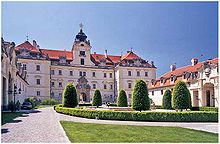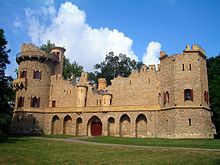Lednice-Valtice cultural landscape
The Lednice-Valtice Cultural Landscape ( Lednicko-valtický areál in Czech ) has been a UNESCO World Heritage Site in the Czech Republic since December 1996 .
topography

The cultural landscape is located in the South Moravian region . It is largely congruent with the three lordships of Feldsberg, Eisgrub and Lundenburg, all of which belonged to the House of Liechtenstein for many centuries .
The information on the area occupied by the cultivated landscape differ greatly and range from 143 km² to 200 km². Of this, around 80 to 100 km² should be landscaped, the rest of the area is taken up by forest and agricultural and built-up areas. The area protected as World Heritage includes the districts of Břeclav ( Charvátská Nová Ves , Poštorná ), Ladná , Podivín , Valtice ( Úvaly ), Bulhary , Hlohovec , Lanžhot , Lednice ( Nejdek ) and Sedlec . To the west it borders on the UNESCO Biosphere Reserve Dolní Morava (formerly Pálava).
In addition to the municipalities of Valtice (Feldsberg) with Valtice Castle and Lednice (Eisgrub) with Lednice Castle, there are a number of park and staffage buildings and the Lednické rybníky pond in the area . Its four ponds were created as fish ponds at Včelínek ( Niklasgraben ) from the end of the 14th century . The work on this dragged on into the 15th century and was the first large-scale intervention in the area that is today the cultural landscape. Another landscape-defining measure was the creation of numerous avenues , hunting and viewing aisles since the middle of the 17th century.
history
Beginnings
The House of Liechtenstein has been recorded in South Moravia since 1130 . Since 1379, his dominion was expanded to include Feldsberg and Eisgrub, and the property was further consolidated in the 15th century. In 1606, the Liechtenstein family set up a family entrenchment commission, which also included Feldsberg and Eisgrub. The last area with which today's cultural landscape was rounded off was Lundenburg ( Břeclav ) in 1638 .
Creation of the landscape park
Under Prince Karl Eusebius von Liechtenstein , Feldsberg developed into a cultural center in which numerous painters, sculptors, architects and other artists worked for the prince. He had the castle expanded into a prestigious residence, a seven-kilometer-long avenue created between the Feldsberg and Eisgrub palaces, as well as other avenues and a game reserve with corresponding hunting trails . These far-reaching interventions in the landscape represent the first steps towards the cultural landscape that will later be formed from them. There were also gardens: first in Italian, later in French style. His successor, Johann Adam I. Andreas , succeeded in stabilizing the rule and later even expanding it, despite the immense debts that Karl Eusebius left behind. He continued to invest in art and architecture and managed to win over Johann Bernhard Fischer von Erlach for a series of construction work . Under his successor, Anton Florian , the first large formal garden of the Hoch baroque was laid out in the later cultural landscape near Schloss Feldsberg . The successors also continued to invest in expanding the facilities. Alois I. Joseph von Liechtenstein turned to the English landscape garden after taking office in 1781 . The park was extended into the landscape via avenues and the water management was fundamentally redesigned. The landscape was continuously provided with staffage structures. His successor, Johann I. Josef , also expanded the landscape garden in the garden landscape according to the English romantic principles of landscape architecture until the "three Liechtenstein dominions into a bucolic Arcadia" were finally designed in the second decade of the 19th century. The border castle , completed in 1827, was the last major addition to the park. The Prince of Liechtenstein represented and wanted to show that he was at the forefront of agriculture, forestry and horticulture.
19th and 20th centuries
In the following changes were made, some of which were due to changed tastes - such as the rebuilding of Eisgrub Castle in a neo-Gothic style - or which resulted from technical developments, such as the connection to the railway . Prince Alois II. Josef set up a route via Lundenburg (Břeclav) for the Emperor Ferdinand's Northern Railway . The line between Vienna and Brno was opened on July 7, 1839. Since 1901 Lednice has had a rail connection on the Boří les – Lednice railway line . Prince Johann II had botanical interests. He founded the Higher Fruit and Horticultural School in Eisgrub and the Mendeleum Research Institute , which opened in 1912 and named after Gregor Mendel , who had discovered the Mendelian rules that were named after him 40 years earlier . Wilhelm Lauche worked as a gardener for Johann II . At the end of the 19th century, the parks around the two castles in Eisgrub and Feldsberg were redesigned. In the time before the First World War , the buildings in the cultural landscape were completely repaired once again by the Prince's architect, Carl Weinbrenner .
Until the end of the First World War, the state border between Moravia and Lower Austria ran directly through the ponds south of Lednice. The Treaty of Saint-Germain beat the hitherto Lower Austria belonging Feldberger country but for strategic reasons of Czechoslovakia to. The border has since been in contrast to the previous border now much further south. During the land reform, the Liechtensteiners lost 60% of their property.
After Austria was annexed to Germany, the Munich Agreement was reached in 1938 that provided for the transfer of the majority of German-speaking areas to Germany. The new state border, valid from the beginning of October 1938, was now north of Lednice, so that the entire cultural landscape was now on German territory. Parts of the population were expelled according to racist criteria . During the Second World War , the Liechtensteiners succeeded in evacuating most of their art collections from South Moravia (and Vienna) to Vaduz . The historic town center of Lundenburg was largely destroyed during an air raid on November 20, 1944, and Eisgrub also suffered considerable damage.
The re-established Czechoslovak Republic expropriated the Liechtensteiners after the end of the war on the basis of Decree No. 108 of the President of October 25, 1945 , although the Liechtensteiners were not Germans according to the wording of the law. This expropriation without compensation has been a burden on the relationship between the Principality of Liechtenstein and the Czech Republic to this day. There are no official diplomatic relations between the two states.
The location of the cultural landscape directly on the Iron Curtain resulted in decay after 1945, but also prevented interventions by modern infrastructure.
present
In December 1989, with the Velvet Revolution, the demolition of the border barriers began, a development which, with the complete abolition of border controls after the Schengen Agreement in 2007, restored the situation as it had existed until 1918.
In 1992 the cultural landscape was declared a monument zone - the first monument zone in the Czech Republic to encompass a landscape - it was recognized as a UNESCO World Heritage Site in 1996 and then gradually restored. Even today, the area is one of the largest landscape parks in Europe.
Movie
- The Lednice-Valtice Cultural Landscape. Documentary, Germany, 2013, 52 min., Script and director: Eva Jobst, moderation: Wladimir Kaminer , production: MDR , series: Diesseits von Eden, first broadcast: September 8, 2013 by arte , summary by arte.
literature
- Filip Binder: The gardens of Prince Alois I Joseph von Liechtenstein in Eisgrub and Felsberg and the influence of travel on their design . In: Die Gartenkunst 32. 1/2020, pp. 95–106.
- Zdeněk Novák: Eisgrub-Feldsberg in Moravia. An important document of landscape design in Central Europe . In: Die Gartenkunst 6 (1/1994), pp. 89-104.
- Pavel Zatloukal (eds.), Pŕemysl Krejčiŕik and Ondŕej Zatloukal: The Lednice-Valtice Cultural Landscape . Foibos Books, Prague 2012.
Web links
- UNESCO: database entry
- UNESCO: map of the protected area
- Diploma thesis on the Lednice-Valtice area ( MS Word ; 215 kB)
Remarks
- ↑ Both details can be found in the UNESCO documents (cf. [1] ); Novák: Eisgrub-Feldsberg , p. 89, also mentions 200 km²; Zatloukal: The cultural landscape , p. 6, names 161 km².
Individual evidence
- ^ UNESCO: World Heritage Committee. Twentieth Session, Merida, Mexico. 2-7 December 1996 , p. 64 [PDF].
- ↑ Zatloukal: Die Kulturlandschaft , p. 6.
- ^ Novák: Eisgrub-Feldsberg , p. 101.
- ↑ Zatloukal: Die Kulturlandschaft , pp. 163–165.
- ↑ Zatloukal: Die Kulturlandschaft , pp. 156–159.
- ↑ Zatloukal: Die Kulturlandschaft , p. 12.
- ^ Zatloukal: Die Kulturlandschaft , p. 15.
- ^ Zatloukal: Die Kulturlandschaft , p. 17.
- ^ Novák: Eisgrub-Feldsberg , p. 90.
- ↑ Novák: Eisgrub-Feldsberg , p. 89f.
- ^ Zatloukal: Die Kulturlandschaft , p. 17.
- ^ Zatloukal: Die Kulturlandschaft , p. 17.
- ^ Zatloukal: Die Kulturlandschaft , p. 19.
- ^ Zatloukal: Die Kulturlandschaft , p. 20.
- ^ Zatloukal: Die Kulturlandschaft , p. 21.
- ↑ Zatloukal: Die Kulturlandschaft , p. 22.
- ^ Zatloukal: Die Kulturlandschaft , p. 31.
- ^ Zatloukal: Die Kulturlandschaft , p. 31.
- ^ Novák: Eisgrub-Feldsberg , p. 89; Novák: Eisgrub-Feldsberg , p. 102.
- ↑ Zatloukal: Die Kulturlandschaft , p. 33.
- ^ Zatloukal: Die Kulturlandschaft , p. 78.
- ^ Zatloukal: The cultural landscape , p. 35.
- ↑ Zatloukal: Die Kulturlandschaft , p. 34.
- ^ Zatloukal: Die Kulturlandschaft , p. 36.
- ^ Zatloukal: Die Kulturlandschaft , p. 36.
- ↑ Zatloukal: Die Kulturlandschaft , p. 37.
- ↑ Zatloukal: Die Kulturlandschaft , p. 37.
- ↑ Zatloukal: Die Kulturlandschaft , p. 6; Novák: Eisgrub-Feldsberg , p. 89.
- ↑ Zatloukal: Die Kulturlandschaft , p. 38.
- ↑ Homepage of UNESCO .








